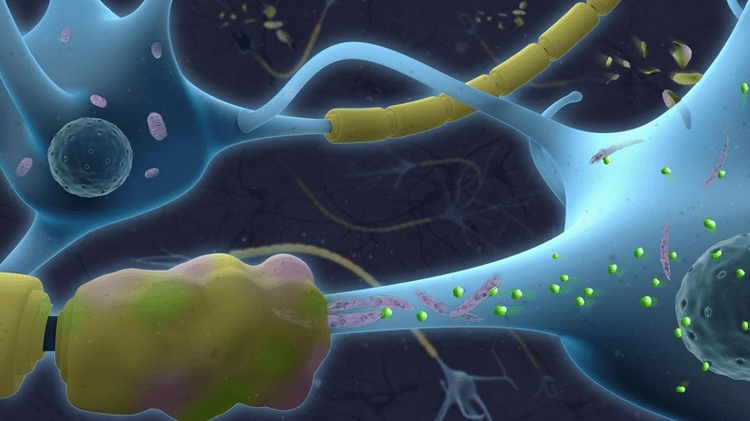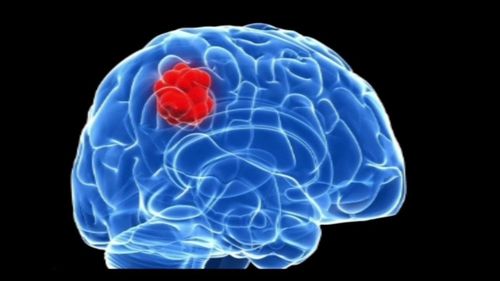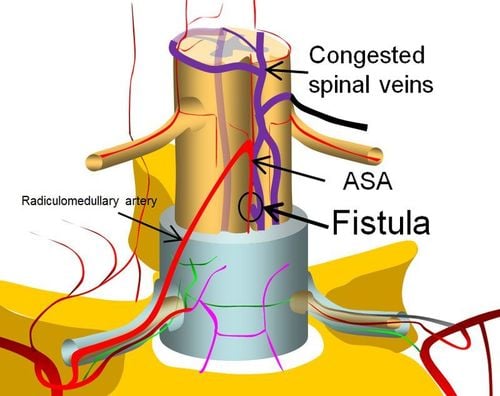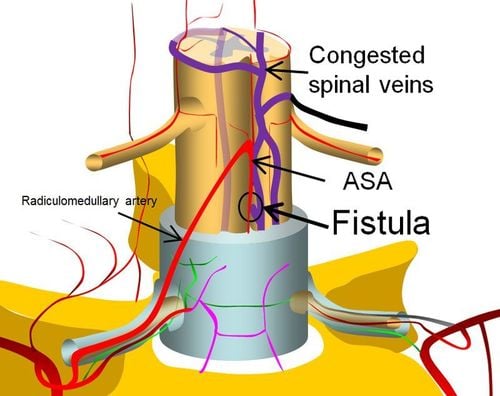This is an automatically translated article.
Marrow vascular malformation is a congenital but very dangerous disease with the potential to cause sudden paralysis or sudden death. Intramedullary vascular malformation surgery is an effective treatment option in the current period.
1. Overview of spinal vascular malformations
1.1 What is a spinal vascular malformation?
Marrow vascular malformation is a congenital disease caused by a disorder in the development of blood vessels from the fetal stage. The age group presenting with marrow vascular malformations is 30-60 years old. The disease is more common in men than in women. Vascular malformations can occur in any segment of the spinal cord, but most commonly occur in the thoracic spinal cord, thoracic spine segments 7 and 8. In fact, it is possible for multiple vascular malformations to form in multiple spinal segments of a single spinal cord. patient.

Nam giới có xu hướng mắc bệnh dị dạng mạch máu tủy nhiều hơn nữ giới
1.2 Symptoms of spinal vascular malformations
Medullary vascular malformations can progress silently, with no symptoms for a long time until the blood vessels become excessively dilated, press on the pulp and nerves, or burst, causing spinal cord haemorrhage. living. Common symptoms depending on the location of the spinal vascular malformation:
The malformation is located in the cervical spinal cord: The patient may experience numbness and weakness in the legs and arms, leading to paralysis of the legs and arms, apnea, leading to death. if not treated promptly; Deformity mass located in the thoracic or lumbar spinal cord: Slowly numb the legs, then atrophy the muscles of both legs, unable to walk, paralysis of both legs, urinary incontinence. Patients with intramedullary vascular malformations usually have no or very little pain. When the vascular malformation ruptures, the patient may experience pain and sudden paralysis. Manifestations of spinal vascular malformations caused by the following groups of symptoms: Spinal ischemia, spinal cord compression, intramedullary bleeding or subarachnoid space bleeding:
Spinal cord ischemia: Stage The head is usually transient, there are paresthesias in the lower extremities, there may be bowel and bladder dysfunction. In the late stage, partial or complete transverse spinal cord syndrome appears; Spinal cord or spinal subarachnoid bleeding: Causes local back pain, pain that radiates across the waist and down the legs. Stiff neck, recurrent spinal cord bleeding. It is important to distinguish symptoms of spinal vascular malformations from intramedullary myeloma, spinal myeloma, epidural hematoma, transverse myelitis, disseminated encephalomyelitis, cerebrospinal syphilis, and disease of the columns and bundles in the spinal cord. ,...
1.3 Treatment of vascular malformations
If left untreated, a spinal vascular malformation can rupture, causing damage to the marrow, leading to disability or death. In addition, the disease also causes complications such as paralysis of both legs, urinary incontinence, infections and sores caused by lying motionless, etc. At the same time, the patient also becomes a burden for the family.
The treatment of the disease is very difficult, depending on the extent of the disease that can be cured or partially treated. Surgical removal of vascular malformations in the pulp is a method that has been applied for a long time. Recently, endovascular intervention method has been applied with advantages such as high efficiency, safety and less invasiveness.
2. Details of surgical methods for spinal vascular malformations
2.1 Indications/contraindications
Indications
Absolute indication for surgery for patients with hemangiomas and spinal vascular malformations; Indications for surgery are relatively large in cases of high cervical spinal cord malformation. Contraindications
Having severe systemic diseases; There is a high cervical spinal cord lesion that is too large in size and the prognosis for surgery is not favorable; Patients with late stage, old and weak health, with advanced pulmonary tuberculosis or obvious malignancies of the spine, widespread metastases.

Bệnh nhân lao phổi không được chỉ định phẫu thuật
2.2 Preparation for surgery
Personnel performing: Surgeons, surgical assistants, nurses, anesthesiologists; Technical equipment: Routine spine surgery kits (scalpel, trigger, disc clamp, needle-carrying pliers, suction machine, electric knife,...) and consumable tools (gauze, cotton) , sutures, skull wax,...); Patients: Be clearly explained about the purpose of the procedure, the procedure, the risk of complications during and after surgery (complications related to damage to the spinal cord or nerve roots); hygiene, enema on the anal canal the night before surgery; Medical record: Completed in accordance with regulations, with the commitment of the patient's family.
2.3 Performing surgery
Position: Place the patient in the prone position, elevate the 2 pelvic and shoulder spines; Anesthesia: Endotracheal anesthesia; Use an intraoperative X-ray machine or count the posterior interspinous space to determine the location of the skin incision; Using a mixture of Adrenalin and Xylocaine 1/10,000 in the paravertebral muscle to anesthetize the surgical area; Incision of the skin, revealing the surgical site is the line next to the spine or the line between the two posterior spinous processes; Open the posterior arch corresponding to the location of the intramedullary vascular malformation; Open the yellow ligament, use trigger pliers or sharp knife to cut the yellow ligament; Epidural opening corresponds to the location of the vascular malformation in the marrow or the hemangioma, exposes and removes the tumor from the spinal cord and nerve roots, and stops bleeding from the vascular branches to and around the tumor. Next, remove the blood tumor or the whole vascular malformation in the marrow, precisely manipulate it to avoid causing damage to the spinal cord and nerve roots; Careful hemostasis; Close the dura; Close the muscle, fascia, subcutaneous layer and dermal layer with suitable sutures. If necessary, drainage can be placed into the surgical cavity.
2.4 Follow-up after surgery
Closely monitor the patient's health status on vital indicators such as respiration, pulse, blood pressure, temperature; Monitor surgical wound bleeding; Monitor for spinal cord injury or nerve root damage.
2.5 Handling of accidents
Tear: Treated by suturing with prolene 4.0 suture; Incisional bleeding: The treatment is enhanced stitches to stop the bleeding; Injury to the spinal cord, nerve roots: Should be treated with corticosteroids combined with functional rehabilitation; Cerebrospinal fluid leak: Treat by re-operating and patching the fistula. Spinal vascular malformation is a congenital disease that is difficult to prevent. However, the patient can prevent the progression of the disease to paralysis or death. To do so, it is necessary to master the symptoms of the disease including numbness in the limbs, dysfunction of the bladder and intestines, local back pain, pain down the legs, paresthesia in the lower extremities,... for early detection. and prompt treatment. And when it is indicated for surgical treatment of spinal vascular malformations, the patient needs to coordinate well with the doctor's instructions.

Phẫu thuật dị dạng mạch máu trong tủy có thể gây rò dịch não tủy
Vinmec International General Hospital with a system of modern facilities, medical equipment and a team of experts and doctors with many years of experience in neurological examination and treatment, patients can completely peace of mind to examine and treat raised intracranial pressure at the Hospital.
To register for examination and treatment at Vinmec International General Hospital, you can contact Vinmec Health System nationwide, or register online HERE.













